Backers are individuals, not numbers. But I love sorting through post-project data to learn from what those numbers reveal. That’s what today’s entry for Between Two Cities is all about.
The intent of these posts is to give other project creators a more detailed, behind-the-scenes look at our data than what they can see on the Kickstarter project page. Please keep in mind that this is data for my fifth board-game related Kickstarter campaign, so if you’re a first-time creator, the percentages may be more relevant than the total values.
Overall Numbers
We’ll start with the bottom line as shown on the Kickstarter page for this 20-day project. These numbers don’t reflect backers who didn’t pay their pledge and backers who paid via PayPal (including most retail backers):
With core pledge levels at $29 and $39, this project needed a lot of backers to work. And it did–5,287 backers is the highest backer total for any Stonemaier project:
- Viticulture: 942 backers
- Euphoria: 4,765 backers
- Tuscany: 4,333 backers
- Treasure Chest: 3,221 backers
- Between Two Cities: 5,287 backers
To me, this is largely a testament of the compelling nature of lower-cost rewards. I think it’s a good idea to expand our user base through some projects with lower costs to entry like this one.
Location Data
The data in the chart below reflects the number of backers who pledged to receive at least 1 copy of Between Two Cities. A BIG part of the reason why I share this data is to help other creators estimate their funding goal–these percentages should help you guess how many backers you’ll have in each region as you budget for various shipping fees.
I was really curious about how this data would turn out for a few reasons. One is that the US dollar was pretty strong during the project, making the game more expensive for non-US backers relative to our previous projects. Ideally the dollar would be weak during our campaigns and then strong when we’re shipping. But that’s not how it worked out this time, and I think it had an impact.
Two is that I decided to use Ideaspatcher for all European fulfillment this time instead of a combination of Amazon.co.uk, Amazon.de, and Ideaspatcher (read about that decision here). So the cost of shipping to France went down a little bit, the cost of shipping to Great Britain went up a little bit, and shipping to Germany jumped from “free” to $9 (there was a $10 shipping subsidy built into every pledge). I think that had a small impact,
Here’s the big picture:
My goal for a while has been to streamline shipping so much that my projects would be just as attractive to international backers as they are to US backers–a 50/50 split. Between Two Cities appears to be a step in the wrong direction for that goal. I think it’s largely attributed to the strong US dollar, but I’d like to find if there are other reasons for the international decline.
Referral Data
Where do backers come from? Kickstarter is only slightly helpful in these regards, as many of the “pledged via Kickstarter” backers probably found out about the project from an external source and then searched on Kickstarter for it. So take this with a grain of salt:
I don’t want to ever rely on Kickstarter to promote my projects–I consider it my job to get the word out there to reviewers, forums, e-newsletter subscribers, etc. Here’s how we’re doing in those regards as compared to previous projects:
- Viticulture: 54% of backers referred by Kickstarter
- Euphoria: 66%
- Tuscany: 48%
- Treasure Chest: 42%
- Between Two Cities: 56%
So, kind of another step in the wrong direction. But the good side is that a number of new-to-Stonemaier backers joined us for the first time. I added 1,100 new opt-in e-newsletters subscribers after the project.
The data below shows backers’ previous exposure to Stonemaier Games. They were allowed to select more than one answer.
There are a few particularly interesting data points here:
- The number of backers who came to the project through my Kickstarter Lessons blog, Facebook, and/or Twitter is quite surprising to me. I think it’s kind of a testament to the power of creating content that others value, then giving them a way to give back to you. Maybe I’m just flattering myself, but I’ve talked about this many times on the blog, and perhaps this data supports that philosophy.
- It didn’t occur to me before this project, but one of the perks of publishing a game by other designers is that they bring in their own fanbases!
- The very last datapoint is illuminating to me about the disconnect between conventions and Kickstarter. Morning Players, our European production partner, had a beautiful, well-attended booth at the Cannes gaming festival during the campaign. They featured Between Two Cities and demoed it to hundreds of people. Perhaps some of them backed the project and didn’t reply to the poll, but the number shown here is quite low.
Finally, here’s Kickstarter’s detailed referral data:
Again, the BoardGameGeek ad seemed like a good investment (though it’s hard to tell exactly how many people came from the ad opposed to the BGG page or forums). Reddit provided a nice, unsolicited boost, as did Kicktraq. And it’s neat to see 25 backers come from Dice Tower News.
Project Video
I love an epic Kickstarter video, but so far I’ve taken the opposite approach: 10-20 seconds of facetime with my business partner to the camera, then a series of images highlighting the project (textual descriptions below, no voiceover–just background music). They’re not the sexiest videos, but I think there’s something compelling and homegrown about them–elements that are increasingly important as the company grows. I want to be responsible about our video budget and maintain a personal look to it.
Did I mention our videos are really short? Before the last Treasure Chest I aimed for 2-minute videos. Now my goal is 1 minute. Here’s a comparison chart for all of our projects:
I think it makes sense that more people will watch the entire video if they see up front that it’s a shorter video. That doesn’t necessarily mean that you should try to make your video 5 seconds long, though. Rather, I think it’s just more supporting evidence that it’s a good idea to cull your visual pitch down to the most compelling elements and cut everything else. You can always put a longer video lower down on the project page.
***
It’s always helpful for me to share this data with readers, as I bet you see some insights in this data that I’m unable to see because I’m so close to it. I look forward to hearing your thoughts in the comments section.
See also: The Top 3 Mistakes I Made on the Between Two Cities Kickstarter Project That You Can Avoid
20 Comments on “Statistics from the Between Two Cities Kickstarter Project”
Leave a Comment
If you ask a question about a specific card or ability, please type the exact text in your comment to help facilitate a speedy and precise answer.
Your comment may take a few minutes to publish. Antagonistic, rude, or degrading comments will be removed. Thank you.
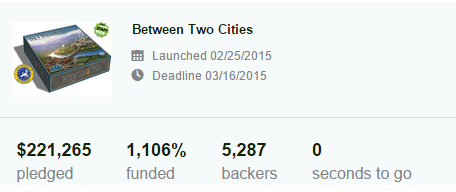
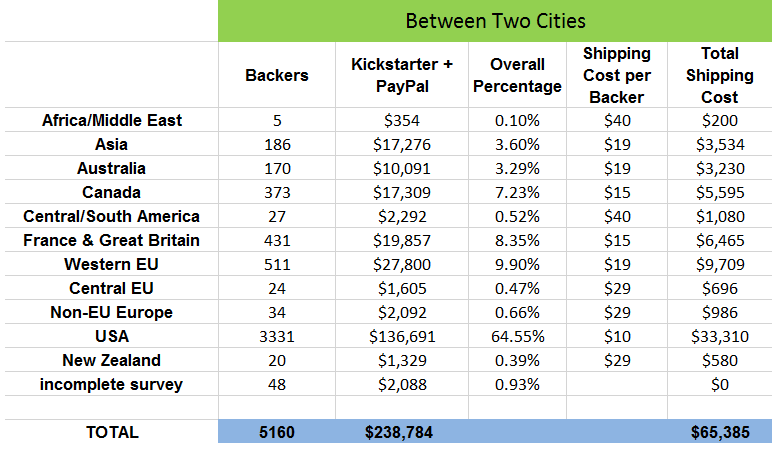

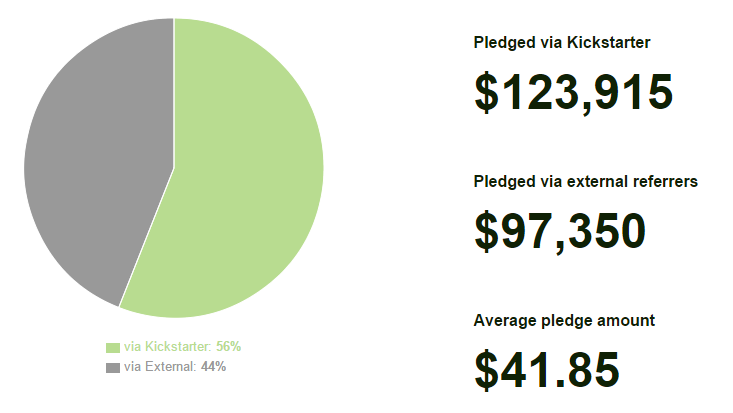
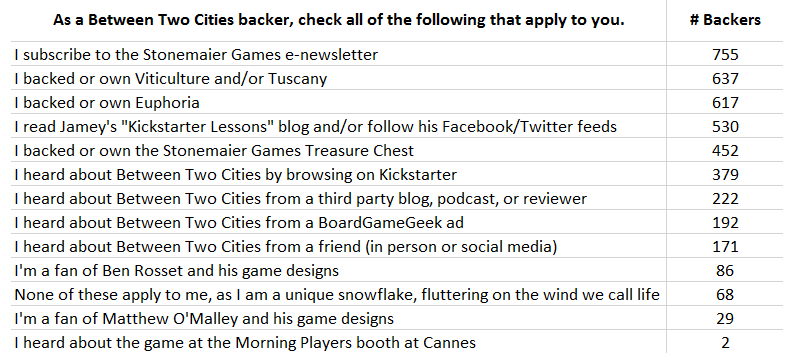
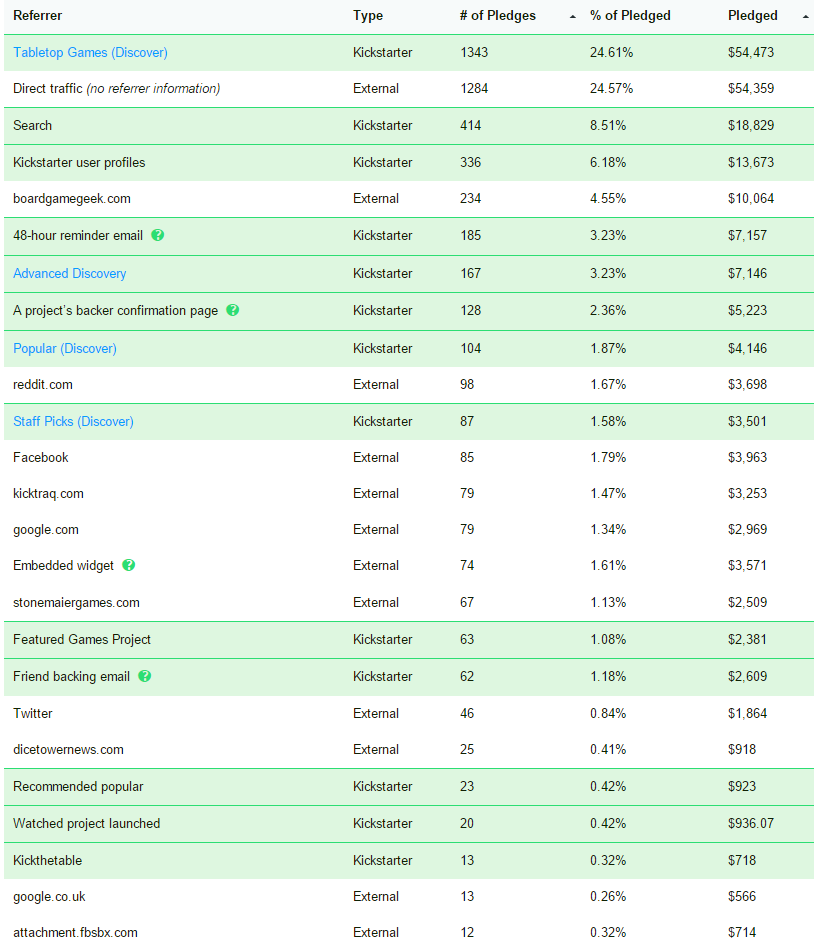

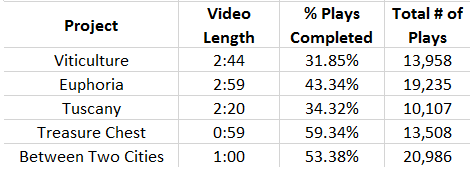


Thanks for posting this Jamey! It’s going to take me a while to digest all of this information however I did have a question about your US/International backer break down. You mentioned that this campaign was a step backward from the 50/50 split but was this due to higher than normal US support or decreased international support this time around?
Gary
Gary: Well, it’s a matter of comparing percentages to percentages, so it’s tough to tell. Probably a combination of both?
I found it interesting that during the Thunderbirds campaign the cost for USD$ dropped about 5$ from the start, due to the strength of the US$
Unrelated to my post about postage. I’d love to test Kickstarters referral analytics system, see how robust it is. I imagine my pledge counts as from KickStarter (search) as that was how I found it when I eventually pledged, but NOT how I first found it. I’ve talked a lot on blogs about how inaccurate referral systems can be, especially since KS seems to revolve around ref= tags… Notoriously unreliable.
I would imagine that the pie for referrals would be swapped entirely (~90k from KickStarter) if the referral system was more robust. That wouldn’t look as good for KS though, so why would they bother to change it?
Like how Microsoft would tout Internet Explorers install base and user base, even though many of those ‘users’ only did so to download a different client, or open links in programs that force use IE for link opening vs default programs.
Thanks for the information regarding video views/completions. Views is obviously going to fluctuate with the popularity of the project itself as well, but the completion percentage shouldn’t.
I know that I personally have been turned away from projects by the pitch video. The goal of the video should be to make me want more information and I think that people make the mistake of cramming it full. There is nothing wrong with multiple videos on your page, but that first pitch video really needs to be spot on.
Do you have any specific thoughts on your use of “text over picture” instead of a voice over? Would you do that again?
Graham: Thanks for your thoughts. I completely agree about the purpose of the video.
I’m pretty low-tech when it comes to videos. I think text over picture is a good fit for me and for some backers, as it lets them watch most of the video without audio at work. I record and create our project videos on my iPad, so if I had a more high-tech setup I might switch to a different format. What do you think?
I hadn’t thought about it allowing people to watch the video without sound. That is a good point and is something to consider.
After thinking on it a bit more, I think it depends on your “acting.” I have seen some pitch videos that use a lot of humor (quite successfully) in the video. For something like this, I think that the ability to hear the person speak is important. It just seems to me that people respond better to a voice as opposed to words on the screen, but as long as the video begins with a vocal introduction, I think you can squeak by on just that.
It is hard to say, but I think a well made video using full voice is better than an equally made video of text. But a poorly made voice video is much worse than a poorly made text video. Voice is harder and has a higher impact level, but it necessitates a minimum level of quality.
Determining that level would be the hard part. Especially since it is going to change from project to project. A project about a book is going to be better served by a text video than a project about a country rock singer is.
Graham: I agree–the factors involved are acting and audio. When you have neither, perhaps the photo/text combo is the way to go. :)
Don’t think that you would lose all those ‘referred by Kickstarter’ backers if Kickstarter would fail. I regularly visit BGG, read your blog, receive your newsletter. Kickstarter just happens to be the first place where I noticed the project. I would have found out about it one way or another.
Leander: Thanks, that’s good to hear. :)
So from the data here, if you made the pledges $33 and $43 you could have made shipping free worldwide ($35 and $45 if you wanted to cover increased international demand). I remember reading on a past blog that you feel this would be a bad idea, but it’s certainly worth wondering if free worldwide shipping would have lead to a higher total number of backers or not.
Sometimes I wish time travel worked if only to do A/B style testing like this.
I’m probably going to go down the free worldwide shipping route on my campaign if I can wrangle shipping prices like yours. As an Australian, I really love your shipping costs, even though the U.S. Dollar has strengthened and ours weakened (was at parity a couple of years ago, now is .7)
Bane: Sure, people love free things. But we might go bankrupt if we do that. :) Also, I don’t like the idea of having some backers subsidize others. It’s easier than ever to charge accurate shipping fees for each individual backer (instead of lumping them into groups that don’t quite fit) now that Kickstarter lets you choose different shipping amounts for each country.
Also, I’m not quite sure where you’re getting those numbers. For example, shipping to the US costs about $10. So $10 was included in the $29 pledge cost ($19 for the game, $10 for shipping). However, shipping to New Zealand costs $29 ($19 for the game, $29 for shipping). $48 is higher than $43. Also, $29 is a much more appealing price point than $33. That $4 increase in price could turn away hundreds of backers.
I concur, the larger price point might turn away backers, so it’s a question of what would have a greater effect, free worldwide shipping (so inherently the same price for every single person around the world) or the slightly higher price point (hence the time travel component I wish we could use) as for the numbers:
65,385 is total shipping amongst 5112 backers. Coming out to a shipping cost of $12.8 per person. You’ve already included $10 worth of shipping into the cost, so if the total cost of every copy was raised by $2.8 everyone could have had free shipping (in a perfect world where this doesn’t cause any change in ratios).
Want me to do the maths on a 50% US instead of your 65% but with an identical number of backers (assuming the ratios of who backs from where remains constant?):
65,385 – 33,310 = 32,075 (current INTL postage)
32,075 / 1781 (# of intl backers) = $18 average amongst intl
5112 / 2 = 2556 (50% of backers)
$25,560 US post cost
$46,008 INTL post cost
Postage cost per backer: $14 exactly. (My original $35/$45 estimate covers increased demand disproportionate in more expensive regions).
I feel it’s not backers subsidising, as KS isn’t a preorder platform, it’s only subsidising in my mind if you are selling a product as opposed to giving a reward for pledging amounts towards the KickStarter. I love that we have a difference of opinion here, and I know based on these figures and ones from other publishers that I will be able to factor free worldwide shipping into my own projects. If my project is successful and I share similar data, maybe we can reach a point where a backer goal costs the same no matter where in the world someone is.
Bane: I would really advise against doing this. The question I always ask is: “What’s the right thing for my backers?” As in, what’s the right thing for each individual backer? The answer can’t possibly be to charge someone more in certain countries just to cover the extremely high shipping cost to other countries. Also, this could do significant damage to your budget, and all backers will suffer if you don’t end up having the funds to ship.
Granted, if your game is small and light, you could use a worldwide fulfillment system directly from China that could drop all prices to the same level. Then you’ll be treating all backers fairly by offering them “free” shipping because the shipping will actually cost the same for all backers. Read more here: https://www.secretbasegames.com/secret-blog/18-good-cheap-fast-global-kickstarter-fulfillment-part-1-why
Firstly, thanks for the resource! Google only shows so many interesting resources, and I’ve tried my best to devour them all. This one is new, and Australian to boot.
For me it’s a question of ‘would individual backers prefer to pay slightly more so that all backers can have a pledge level at the same price’? Backers are already mildly altruistic by nature, so in my mind it’s the perfect audience for such an activity. Maybe it’s the Australian in me, where the concept of ‘fair for everyone’ pervades. It’s probably not like that in America at all, and I wish I could run a poll to find out if people would prefer to pay a slight increase to even the playing field for everyone.
For looking at differences over projects, looking at UK and France together when UK shipping has gone up and French has gone down feels like a bit of a mistake to me. Not one that makes analysis impossible, just one that might hide two possible changes under general noise…
Very interesting read and look forward to getting the game.
Stephen: Yeah, that’s a good point. I lumped them together because they were at a different shipping tier than the rest of Europe.
Interesting observations.
Agree on the video front as well. I’ve noticed a number of projects for some reason have decided to put their gameplay examples into the pitch video. It’s really bad. The main video is your initial pitch and should outline the product and goals as clearly yet briefly as possible. If people want to know how the game plays they will stay on the page and scroll down for more information. If you bore people or can’t sell them within a minute or two they’re going to leave.
Thanks Mark. I agree that gameplay details should be left for another video.